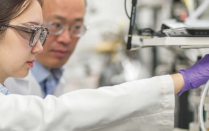CBE earns $7.6 million in grants in ’22 for hydrogen, vaccine and nano research

By Tom Dinki
Published March 9, 2023
Hydrogen. Vaccines. Nanotechnology.
They are potential solutions to some of the world's most pressing challenges, and the UB Department of Chemical and Biological Engineering (CBE) is advancing research on all of them.
CBE, within the School of Engineering and Applied Sciences, received a total of $7.6 million in grants last year for four projects to make hydrogen a more viable clean energy, tailor vaccines for the elderly and perfect the production of nanoparticles.
“This latest influx builds on the momentum of the past few years, which saw new external funding to CBE increase to over $12 million in the 2021-22 fiscal year. It should grow even further in the current year,” says Mark Swihart, SUNY Distinguished Professor and chair of CBE. “Ultimately, this funding helps us advance the frontiers of science and engineering for the benefit of society, and train our graduate students, who are the future leaders in these fields.”
ON THIS PAGE
Separating clean hydrogen from carbon dioxide
Biomass gasification – the process of using steam to convert wood and other plant waste into hydrogen – could be key to achieving net zero emissions of greenhouse gases.
Yet this same process can also release greenhouse gases into the atmosphere, as the plants used for biomass fuel have stored carbon dioxide within them.
With the help of a $1.6 million grant from the U.S. Department of Energy, CBE researchers are trying to produce hydrogen while separating the carbon dioxide into a different gas stream using membrane reactors.

Haiqing Lin
The funding, which began in October, will be supplemented by $500,000 in matching funds from New York State.
Swihart, a co-principal investigator on the project, says the research team will develop new catalysts for the gasification process, improve membranes to separate the hydrogen from the other gases, and even store the carbon dioxide so that it can be used for other processes.
“This moves us toward a circular carbon economy, where rather than burning fuels and releasing the carbon into the atmosphere, we feed that carbon back into the system,” he says.
The project’s principal investigator is Haiqing Lin, professor and director of graduate studies for CBE. Carl Lund, SUNY Distinguished Teaching Professor in CBE, is also a co-principal investigator.
Using ammonia to affordably ship hydrogen
Another issue holding back a hydrogen economy is that the fuel is so costly to ship. The idea of converting hydrogen into ammonia, which is easier to liquefy and, therefore, less expensive to store and transport, has gained traction in recent years.

Miao Yu
How best to then convert ammonia back into hydrogen is a question being tackled by Miao Yu, SUNY Empire Innovation Professor in CBE, through a two-year, $1.5 million grant from the Advanced Research Projects Agency-Energy (ARPA-E). The funding, part of the largest ARPA-E grant ever awarded, is also being matched with $500,000 from New York State.
Research Triangle Institute is leading the project.
“The goal of our project is to engineer a highly energy-efficient prototype for hydrogen production from ammonia decomposition,” Yu says. “This may make it possible for using ammonia as a fuel on vehicles with hydrogen fuel cells.”
Yu’s team is creating an integrated system composed of a highly active catalyst for ammonia decomposition, hydrogen-selective membrane and catalytic hydrogen burner. At the end of the project, they plan to field test a prototype installed on a vehicle that produces 5 kilograms of hydrogen per day.
Tailoring vaccines for older adults
Older adults are more susceptible to severe cases of pneumonia, making it all the more crucial that they be vaccinated against it.
Yet vaccines are often not as effective in older adults.
“As we age, there is just natural deterioration to our immune system,” says Blaine Pfeifer, professor in CBE. “We're trying to account for that with a more potent vaccine design.”

Blaine Pfeifer
Pfeifer is the principal investigator on a five-year, $2 million grant from the National Institutes of Health (NIH) to design a pneumonia vaccine tailored specifically for older patients. The funding, which began in August, is in collaboration with the Jacobs School of Medicine and Biological Sciences at UB. Elsa Bou Ghanem, assistant professor in the Department of Microbiology and Immunology, is the co-principal investigator.
The work will build on Pfeifer’s prior vaccine research, which uses carrier systems to prompt a more comprehensive immune response. The research takes inspiration from Prevnar-20, a Pfizer-produced pneumonia vaccine for those 65 years or older.
Pfeifer’s team will try to extend Prevnar-20’s capabilities and potency, as well as protect against pneumonia brought on by the flu.
“Part of our proposal is to address this flu-pneumoniae one-two punch,” Pfeifer says.
Making nanoparticles out of bacteria
Nanotechnology is a key part of military research, as the tiny particles can be used for everything from better body armor to avoiding radar detection.
The Defense Advanced Research Projects Agency (DARPA) has awarded Swihart and Pfeifer, along with colleagues from the UB Department of Chemistry and Universidad Andrés Bello in Chile, a $1 million grant to study the microbial production of nanoparticles.
“This is a high-risk, high-reward project that aims to use bacteria to produce nanoparticles containing rare-earth elements – things found in that extra row at the bottom of the periodic table, like erbium, ytterbium and neodymium,” Swihart says. “Such nanoparticles have valuable optical and magnetic properties. We use them to convert light from one wavelength to another in ways that cannot be done by other materials.”
Researchers can modify common bacterial cells, as well as more exotic strains from extreme environments, to improve their ability to create inorganic nanoparticles. The bacteria are exposed to the rare-earth elements and respond by converting metal ions into particles and excreting them.
Rare-earth elements are widely used in electronic devices and electric motors and generators. Thus, they are both a valuable tool and a significant component of electronic waste.
“We are focused on using bacteria to make specific materials from supplied precursors, but, ultimately, bacteria could be used to collect these materials in the environment, like as part of wastewater processing, converting them from a contaminant to a value-added product,” Swihart says.
Paras Prasad, SUNY Distinguished Professor in the UB Department of Chemistry, is the principal investigator on the grant, while Swihart and Pfeifer are co-principal investigators.


